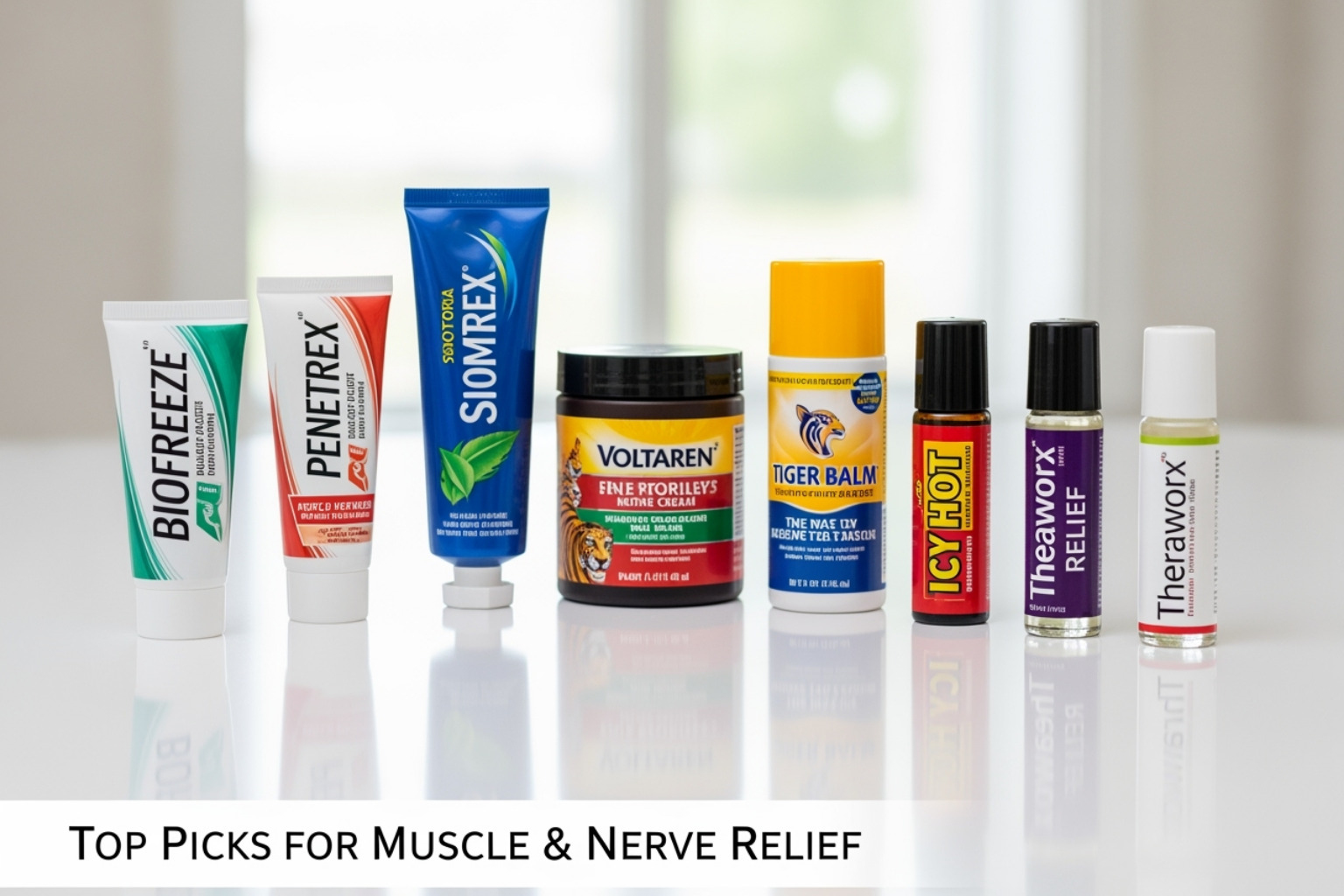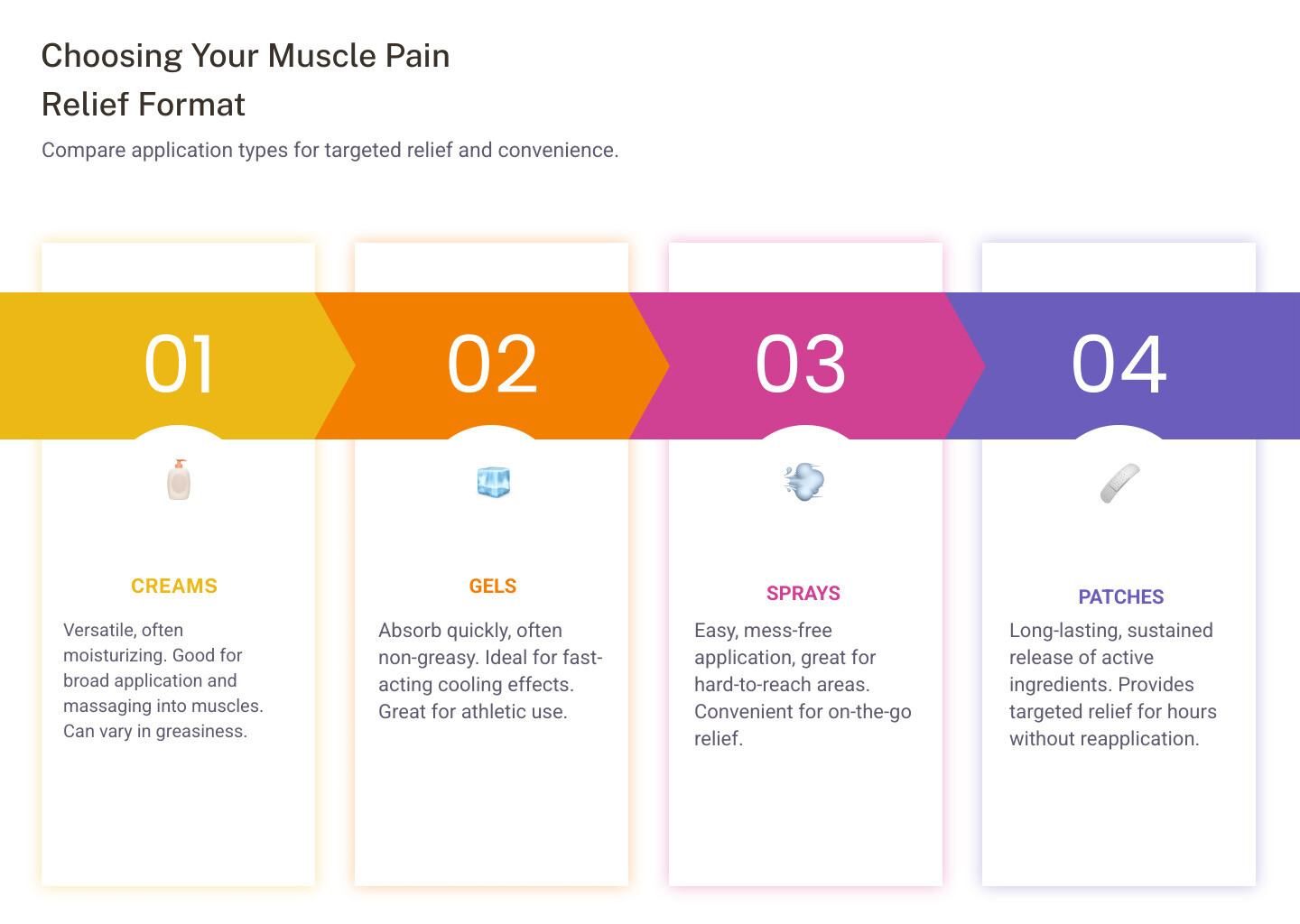Why Finding the Right Pain Relief Cream Matters for Your Recovery
Deciding what cream is good for sore muscles depends on your pain type, skin sensitivity, and desired sensation. Whether you need cooling, warming, or numbing relief, topical creams offer targeted support without the side effects of oral medications. They work by creating sensations that distract your nerves from pain or by delivering ingredients that reduce inflammation at the source.
| Pain Type | Best Cream Type | Key Ingredient |
|---|---|---|
| Post-workout soreness | Cooling menthol cream | Menthol |
| Chronic stiffness | Warming balm | Camphor, Capsaicin |
| Nerve pain | Lidocaine cream | Lidocaine |
| General muscle aches | Natural anti-inflammatory | Arnica, Aloe, MSM |
| Sensitive skin | Fragrance-free gel | Aloe, Urea |
The challenge is that not all creams work the same. Some use menthol for an icy sensation that dulls acute pain, while others use warming agents like camphor to relax stiff muscles. Natural formulas with arnica and MSM target inflammation, and lidocaine-based creams numb nerve pain directly. Research shows that topical lidocaine can effectively reduce pain for conditions like neuropathy, while arnica may offer pain relief comparable to some oral pain relievers.
I'm Tony Enrico, and I've spent years helping people find effective, natural, and fast-acting formulas for sore muscles. In this guide, I'll walk you through expert-approved recommendations to help you choose the right cream for your specific pain.

Understanding How Muscle Pain Relief Creams Work
When muscle soreness strikes, many of us reach for a pain relief cream. But how do they work? It's not magic; it's science. Topical creams interact with your nervous system, creating sensations that distract your brain from pain signals or delivering active ingredients that reduce inflammation or numb the area. Understanding these mechanisms is key to figuring out what cream is good for sore muscles in your specific case. Topicals are most effective when absorbed into painful tissues, where they can stimulate the skin to create a distraction from the underlying pain.

Key Active Ingredients and Their Roles
The power of any muscle cream lies in its active ingredients. Here are the most common and effective ones:
Counterirritants like menthol, camphor, and methyl salicylate create a strong cooling or warming sensation. This sensory input distracts your brain from the deeper muscle pain. Menthol triggers cold receptors for a refreshing icy feeling, while camphor can also produce a cooling effect. Methyl salicylate, found in many warming rubs, creates heat while also acting as a topical analgesic.
Analgesics like lidocaine take a more direct approach. As a local anesthetic, lidocaine blocks nerve signals right where you apply it. A 4% concentration is the strongest available without a prescription. A 2021 study found that topical lidocaine can significantly reduce pain for various conditions, including neuropathy, carpal tunnel syndrome, and chronic lower back pain.
NSAIDs (non-steroidal anti-inflammatory drugs) like diclofenac and ketoprofen work differently. Applied topically, they penetrate the skin to directly reduce inflammation by blocking pain- and swelling-causing substances called prostaglandins. This makes them excellent for localized arthritis and muscle strains.
The Great Debate: Cooling vs. Warming Creams
Cooling creams, with ingredients like menthol and camphor, create an icy sensation that soothes acute injuries, fresh strains, or post-workout soreness. The cooling effect constricts blood vessels, reducing localized swelling, similar to an ice pack. A cooling menthol formula slows blood flow, which helps distract from pain. Research shows how menthol cools skin and affects blood flow, making it ideal for immediate relief.
Warming creams often contain methyl salicylate, camphor, or capsaicin to generate gentle heat. This increases blood flow, which helps relax muscles, ease stiffness, and alleviate chronic pain. The increased circulation also delivers more oxygen and nutrients to tired tissues, aiding recovery. For acute pain with swelling, choose a cooling cream. For deep, persistent aches or stiffness, a warming cream will likely provide better comfort.
The Power of Natural Ingredients in Muscle Rubs
Many creams harness the power of natural botanicals for a gentler approach to pain management.
- Arnica: This herbal extract is known for its anti-inflammatory properties and ability to minimize swelling and bruising. A 2017 study analysis reported that arnica may possess anti-arthritic properties and could offer pain relief comparable to ibuprofen.
- Capsaicin: Derived from chili peppers, it creates a warming sensation and works by blocking pain signals, making it effective for chronic pain or stiffness. For more details, check out our articles on Capsaicin Cream Uses & Benefits and From Spice to Science: A Deep Dive into Capsaicin.
- CBD (Cannabidiol) and hemp: These have gained attention for their potential anti-inflammatory benefits. Research suggests CBD can make pain feel less unpleasant when applied topically.
- MSM (Methylsulfonylmethane): This sulfur compound is known for its anti-inflammatory properties. Research from the National Library of Medicine suggests emu oil also offers anti-inflammatory benefits when applied topically.
- Essential oils: Peppermint, eucalyptus, and lavender are common in pain relief formulas for their cooling, warming, or muscle-relaxing properties.
What Cream Is Good for Sore Muscles? Our Top Pick
Finding the right muscle pain relief cream shouldn't be a puzzle. To help you decide what cream is good for sore muscles, we're highlighting our top recommendation based on effectiveness, natural ingredients, and fast-acting relief.

Best All-in-One Solution: Neuropasil Pain Relief Cream
When you need a cream that covers all the bases, Neuropasil Pain Relief Cream delivers comprehensive, fast-acting relief for both muscle and nerve pain. We designed this cream to be your go-to solution for everything from everyday aches to more persistent discomfort.
Why It Works: Neuropasil stands out with its powerful blend of natural ingredients. Arnica and MSM tackle inflammation, while Menthol creates a pleasant cooling sensation that distracts your nerves from pain signals. This makes it perfect for the acute pain and inflammation from a tough workout. The formula is rounded out with Aloe and Urea, which provide hydration and ensure the cream absorbs quickly without a greasy, sticky feeling.
Who It's For: Our customers rely on Neuropasil for post-workout soreness, muscle strains, and chronic conditions like neuropathy, sciatica, and plantar fasciitis. Because it's formulated with natural ingredients and has a mild scent, it's also a great choice for those with sensitive skin who need effective relief without harsh chemicals or strong fragrances. The non-greasy, fast-absorbing application makes it perfect for use anytime, anywhere.
If you're curious about the science behind our formula or want to explore more, check out our Ultimate Guide to Muscle Relief Cream and see why Neuropasil ranks among the Best Products for Muscle Pain. You can also Discover the Power of All Natural Relief in our detailed guide.
Choosing the Right Product for You
Finding what cream is good for sore muscles is a personal decision. The key is to understand your specific needs, from your type of pain to your skin's sensitivity and even your preference for certain textures and scents.

For Athletes vs. Sensitive Skin
Athletes often need high-strength formulas that deliver fast, powerful relief to get back in action. Products with robust concentrations of menthol are popular because they work quickly to interrupt pain signals. Our guide on How Neuropasil Helps Athletes with Muscle Recovery Pain explores how targeted relief can support your training.
However, if you have sensitive skin, a gentler touch is required. High concentrations of some ingredients, artificial fragrances, and certain preservatives can cause irritation. For you, fragrance-free formulas or creams built around soothing natural ingredients like aloe and arnica are best. Always perform a patch test by applying a small amount to your inner forearm and waiting 24 hours to ensure your skin tolerates the formula.
Finding a Non-Greasy, Pleasant-Smelling Cream
The sensory experience of a cream matters. If you dislike a greasy feeling, look for products labeled "non-greasy" or explore our Gel Muscle Pain Relief options. Gels typically absorb faster and leave less residue than thick creams or balms.
When it comes to scent, you have choices. If the sharp, medicinal aroma of some products is off-putting, seek out fragrance-free formulas or those scented with essential oils for a more subtle experience. Reading user reviews can also provide valuable insight into a product's real-world smell and feel.
Short-Term Relief vs. Long-Term Recovery
Topical creams are excellent for managing pain, but they don't instantly heal damaged muscle tissue. It's important to understand that these creams primarily interfere with pain signals, providing comfort rather than directly repairing muscle fibers, a point often emphasized by physical therapists. Our article on Muscle Pain Relief Oral vs. Topical Options dives deeper into this.
For immediate, short-term relief, counterirritants like menthol and anesthetics like lidocaine excel. For supporting your body's natural recovery, ingredients with anti-inflammatory properties like arnica, MSM, and topical NSAIDs can help create a better environment for healing. Use topical creams for comfort while practicing recovery fundamentals like rest, hydration, and proper nutrition. For more on this, see our guides on Muscle Pain Treatments and Targeted Muscle Pain Solutions.
Safety, Precautions, and When to See a Doctor
While muscle pain relief creams are a fantastic tool, use them safely and know when your pain might signal something more serious.
How to Use Creams Safely
The most common side effect is skin irritation. Always perform a patch test on a small area of skin first. If you notice redness, itching, or excessive burning, stop using the product.
Here are some key safety rules:
- Never apply creams to broken or damaged skin. This can lead to excessive absorption and worsen skin damage.
- Keep creams away from your eyes and mucous membranes. They are for external use only.
- Wash your hands thoroughly after application to prevent accidental transfer.
- Do not combine warming creams with heating pads, as this can cause skin burns.
- Follow product instructions regarding application frequency. It is crucial to follow product instructions regarding the recommended frequency and duration of use, as overuse can lead to side effects.
For general guidance on common aches, refer to our articles on Muscle Aches and Muscle Soreness.
When Your Sore Muscles Might Be Something More
Most muscle soreness is temporary, but sometimes it's a sign of a more serious issue. Consult a doctor if:
- Pain persists for more than a week despite home care. Many products, such as those containing menthol, advise against use for more than 7 days without medical recommendation.
- You experience severe or worsening pain that doesn't respond to OTC remedies.
- You suspect a muscle strain, sprain, or other injury.
- Your pain is accompanied by fever, significant swelling, redness, numbness, or weakness. These could indicate an infection, nerve damage, or another serious condition.
A healthcare professional can accurately diagnose the cause of your pain and recommend the right course of action. Sometimes, figuring out what cream is good for sore muscles means first understanding if a cream is the right answer.
Frequently Asked Questions about Muscle Pain Relief Creams
We understand you have practical questions about using muscle creams. Here are answers to some of the most common ones we hear from people trying to figure out what cream is good for sore muscles. For a broader overview, our article on Muscle Pain is a great starting point.
How long does it take for muscle relief cream to work?
Many creams start working quickly. Products with counterirritants like menthol or camphor often produce a cooling or warming sensation within minutes. This provides an immediate sensory distraction from your pain. For ingredients that need to absorb deeper, like topical NSAIDs or anesthetics, the full analgesic effect might take 15 to 30 minutes to kick in. Most people feel some initial comfort very quickly.
Can I use muscle pain relief cream every day?
It depends. Many OTC creams are safe for daily use—even several times a day—if you follow the label directions. However, these creams are meant for temporary relief. If you find yourself needing a cream every day for more than a week without improvement, it's time to call your doctor. Persistent pain could signal an underlying issue that needs a different approach. Many products, especially those with counterirritants or topical NSAIDs, advise against use for more than 7 days without medical guidance.
Do muscle rubs actually heal muscles?
This is a common misconception. Muscle rubs are fantastic for managing pain, but they don't "heal" muscles by repairing torn fibers. As explained by physical therapists, topicals primarily interfere with the pain signals sent to your brain. They provide comfort by distracting your nervous system or numbing the area.
Think of your cream as a supportive tool. By managing your symptoms, it allows you to rest and engage in activities that support healing, like stretching and proper nutrition. For strategies on recovery, check out our guides on What Helps Sore Muscles After Workout and Reduce Muscle Soreness After Workout.
Conclusion
Finding what cream is good for sore muscles is a journey unique to each individual. We've explored the diverse world of muscle pain relief creams, from the science behind their active ingredients to specific product recommendations and crucial safety considerations. Whether you're an athlete pushing your limits or simply experiencing daily aches, there's a topical solution designed to help you find comfort.
Remember these key takeaways:
- Cooling creams (menthol, camphor) are often best for acute pain, fresh injuries, and inflammation.
- Warming creams (methyl salicylate, capsaicin, camphor) are ideal for stiffness, chronic aches, and relaxing tight muscles.
- Lidocaine provides direct numbing for localized pain, including nerve-related discomfort.
- Natural ingredients like arnica, MSM, CBD, and essential oils offer anti-inflammatory benefits and a gentler approach.
- Always prioritize safety: perform patch tests, avoid broken skin, and know when to consult a healthcare professional.
The best cream for your sore muscles is one that effectively addresses your pain, aligns with your preferences, and is used safely. We encourage you to explore our range of natural, fast-acting pain relief creams, like Neuropasil, which are crafted to provide targeted, soothing relief for various types of pain.
Explore our range of fast-acting pain relief creams
References
Throughout this guide, we've drawn on solid scientific research and expert insights to help you understand what cream is good for sore muscles and how these products actually work. The science behind topical pain relief is fascinating, and we believe in backing up our recommendations with credible sources.
The foundation of our understanding comes from comprehensive reviews of topical analgesics and their mechanisms. A 2019 review published in PMC provides an excellent overview of the scientific evidence behind topical analgesics and their common formulations, helping us understand how different ingredients interact with your body to provide relief.
When we discussed cooling creams and menthol's effects, we referenced important research on the role and mechanism of action of menthol in skin, published in PMC in 2013. This study explains how menthol creates that refreshing cooling sensation and influences blood flow, which is crucial for understanding when to choose cooling versus warming relief.
For our recommendations involving lidocaine, we turned to a thorough 2021 study in Drug Design, Development and Therapy that examines topical lidocaine for pain management. This comprehensive review demonstrates lidocaine's effectiveness for various conditions, from neuropathy to chronic back pain. Information on over-the-counter strengths was verified using trusted health resources like WebMD.
Finally, when discussing natural ingredients, we referenced a 2017 analysis in Nutrients that reviews the efficacy of Arnica montana for pain relief. Additional claims about natural ingredients are supported by a 2020 study in PAIN on topical CBD's effect on pain perception and research on the anti-inflammatory properties of emu oil.
Safety guidelines, such as the typical 7-day usage limit for many over-the-counter products, are based on information provided by manufacturers and compiled in databases like the National Library of Medicine's DailyMed. These studies and resources form the backbone of our recommendations, ensuring that when you choose a muscle relief cream, you're making an informed decision based on real science.















